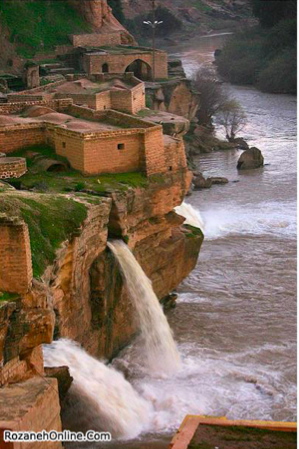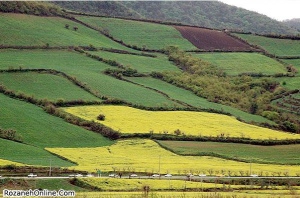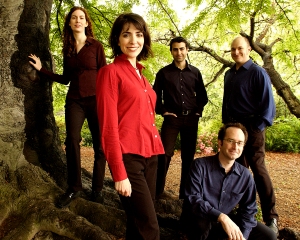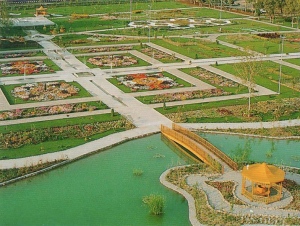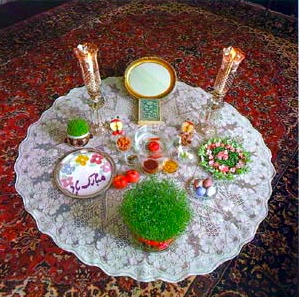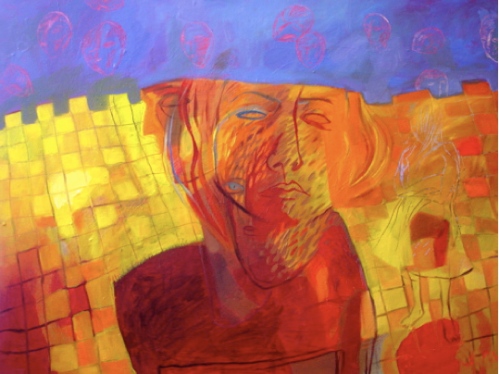Dear All,
I hope you are enjoying the beginning of the summer. St. Louis summers are beautifully green. They can be toasty and wet too. We are enjoying a bit of both at the moment. The news from Iran has both good and disturbing parts. Among the disturbing parts are further American action to create unrest in Iran, as is the Iranian government’s move to tighten its enforcement of the ladies dress code in public and of course the continued anxiety over the arrest of Dr. Esfandiari. Good things include news of continued strong resolve among Iranian women to enhance their presence on the social and political scene by forming new coalitions as well as the usual great artistic and intellectual activity in the country.
One of my goals in these windows is to dispel the myth that reduces Iran to a culture of “villains vs. victims.” I would like you to see that regardless of the internal and global issues that Iran is dealing with, Iranians continue to be a lively, creative, humorous, and art loving people like any other in the world. Here it is in the words of one of the major contemporary Iranian painters Iran Darrudi
http://www.payvand.com/news/07/may/1304.html. Or, read about the three-minute documentary that the renowned Iranian director and screen-writer Abbas Kiarostami made on the occasion of Cannes Film festival’s 60th year. Kiarostami included in his three-minute documentary, 24 top Iranian actresses whom he has worked with over the years: http://www.payvand.com/news/07/may/1226.html.
Visual Delight
Nothing connects cultures like a visit. Let’s take a look at some
recent photos of Iran’s natural beauty (thanks to my friend Bahar
Bastani who sent the images). I have kept the slide show short so your
home computers don’t have large files to deal with. Click here: Iran Natural Beauty.
Recent Visit to Iran
While disturbing news about visits to Iran get a lot of attention, the
happy and successful ones find it hard to get any. My friend Judith
Ernst who visited Iran recently, had promised to share her experience
with us. Judith wrote a beautiful piece which provides a rare window
on Iran as few Americans make such a visits these days. Her
thoughtfully written piece about the trip received little attention
from the national papers. However, fortunately, it was greeted
enthusiastically by on-line news source Commondreams (thank goodness
for the alternative media). Judy was in Iran with her husband, Carl
Ernst, a professor of Islamic Studies at the University of North
Carolina at Chapel Hill, who was invited to a conference on Rumi and
while there received an award for his most recent book, Following
Muhammad: Rethinking Islam in the Contemporary World. I recommend the book highly for personal reading and/or classroom use. Now, for Judy’s take on the trip to Iran click on:
http://www.commondreams.org/archive/2007/05/18/1348/
Current Issues
* And now to the not-so-exciting current news:
According to ABC News, the CIA has received secret presidential
approval to mount a covert “black” operation to destabilize the
Iranian government, current and former officials in the intelligence
community say. The sources, who spoke on condition of anonymity
because of the sensitive nature of the subject, say President Bush has
signed a “nonlethal presidential finding” that puts into motion a CIA
plan that reportedly includes a coordinated campaign of propaganda,
disinformation and manipulation of Iran’s currency and international
financial transactions.
http://blogs.abcnews.com/theblotter/2007/05/bush_authorizes.html
* Though the majority of Americans many not readily connect the two, the
recent harshness on the part of the Iranian government toward Iranians
themselves as well as Iranian American visitors has much to do with
these “regime change” plans cooked here in the U.S. In a letter
recently written by Emaddedin Baghi of Defending Prisoners’
Rights Society in Tehran, Iran and circulated through the
International Society for Iranian Studies here in the US, Mr. Baghi writes:
In recent years, the government of the United States has announced
that it has allocated a yearly budget for the support of civil
society, democracy, and human rights in Iran. This so-called
“democracy fund” is approved by the United States Congress and
extensive media coverage of this financial endeavor has been
encouraged.
Given the existence of long-standing hostilities between the
governments of Iran and the United States, the government of Iran has
shown extreme sensitivity to the idea of individuals or groups
receiving funds to engage in activities that, in the public words of
at least some American officials, is intended for an eventual “regime
change” in Iran. I am sure the United States government would show
similar sensitivity if it was revealed that there were individuals or
organizations in the United States that were receiving funds from
hostile groups or countries intent on creating instability in that
country.”
Mr. Baghi suggests in his letter that “Undoubtedly, not all these
pressures and arrests are reflective of recently developed government
concerns and suspicions. Forces that are against liberty also use the
U.S. budget allocation as a pretext or excuse to legitimize their
opposition to civil liberties and to discredit their critics.”
Nevertheless, he goes on to say: “It is not right for independent
individuals and institutions inside Iran to pay the price for
allocated funds that the United States government spends on
broadcasting from the United States into Iran or for the activities of
exiled Iranian groups that cooperate with various American
organizations.”
Mr. Baghi’s moving letter ends with “This is why I hereby make a plea
to you and your respected organizations to insist that the United
States government change its ways or, in case of its insistence on
allocating a yearly budget, make public and transparent the exact
amount and recipients (individuals and groups) of these funds.”
* On the brighter side, an Iranian woman member of the parliament,
Fatemeh Rakeii has announced a plan to form a coalition of women
political activists to help women gain all their rights in the
political and management arenas. Rakeii described the main goal of the
coalition as “abolition” of gender discrimination. At the same time, a
coalition of reformist women is also about to form in order to
increase women’s seats in the 2008 parliamentary elections. To read
more on these, please visit:
http://www.mehrnews.com/en/NewsDetail.aspx?NewsID=490115
* In these windows, I am always talking about one-sidedness of the media
on Iran/Islam related issues. At the moment, Iran gets the worst
possible press. But the treatment is extended to all Muslims, as my
student Matt Miller noted recently in an e-mail (thanks Matt!). Matt
writes: “There was a poll by Pew that came out today that surveyed the
U.S. Muslim population. Here is the headline that appeared in U.S.
media outlets (via the Associated Press) about the poll: “Some young
Muslims approve suicide hits.” While on the BBC this was the headline
about the same poll: “Muslims ‘well-integrated’ in the U.S..” The
stark contrast in the headlines is incredible. The articles both go on
to talk about the same poll by Pew, yet the AP (U.S.) article focuses
almost exclusively on Muslims and terrorism (citing the 13% of young
U.S. Muslims who approve of suicide attacks to defend religion in
“rare cases”),while the BBC article talks about how U.S. Muslims are
well-integrated into U.S. life, reject terrorism in overwhelming
numbers, and like the U.S. although they don’t often feel welcomed in
the U.S.” Matt finds “incredible” how two stories about the same poll
portray the U.S. Muslim population in such vastly different lights. He
provides the link: http://www.msnbc.msn.com/id/18797530/. Now compare
with: http://news.bbc.co.uk/2/hi/americas/6680939.stm
St. Louis Persian Music Event!
We just have to end on a happier note. What better than the news that my friend Behfar Dianati has sent. Behfar, with help from Iranian American Cultural Society of the Midwest, has organized a concert of Persian music by American musicians called Songs of Love from Iran by the artist Monika Jalili and her group Noorsaaz. The group will perform at the Missouri Historical Society, on Saturday, June 9, at 7:00. If you live in or near St. Louis, come to get a taste of Persian music performed by American artists. And, if you like more information, call (314- 746-4599).
Until the next window, I wish you a great week.
Best,
Fatemeh
===================================
Fatemeh Keshavarz, Professor and Chair
Dept. of Asian and Near Eastern Languages and Literatures
Washington University in St. Louis
Tel: (314) 935-5156
Fax: (314) 935-4399
==================================
